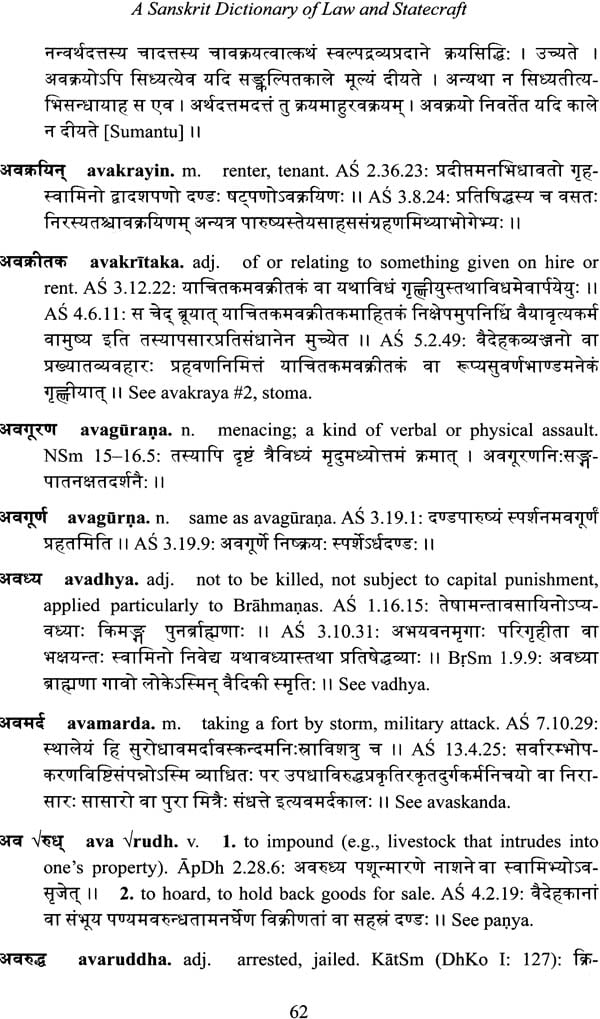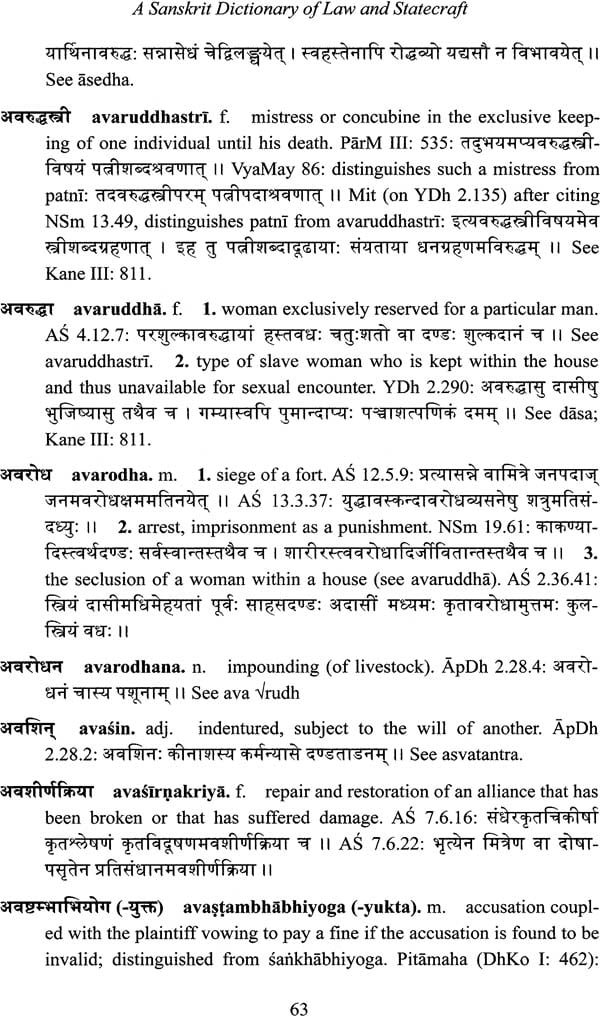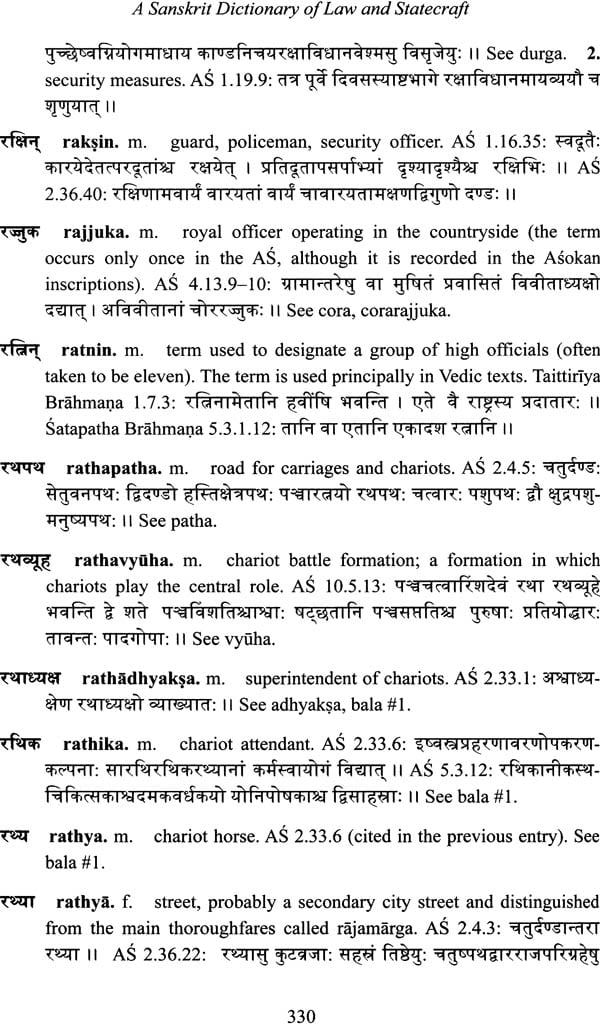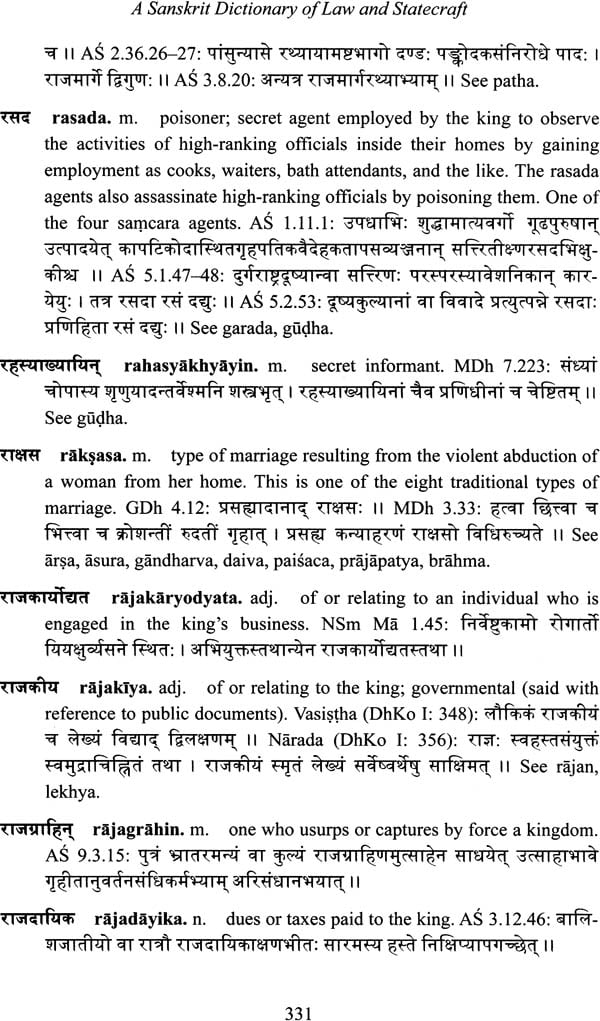
A Sanskrit Dictionary of Law and Statecraft
Book Specification
| Item Code: | NAL952 |
| Author: | Patrick Olivelle |
| Publisher: | Primus Books, Delhi |
| Language: | Sanskrit and English |
| Edition: | 2019 |
| ISBN: | 9789386552211 |
| Pages: | 468 |
| Cover: | Paperback |
| Other Details | 9.5 inch X 6 inch |
| Weight | 670 gm |
Book Description
This Dictionary contains technical terms used in Sanskrit texts of ancient and medieval India dealing with law and statecraft within Dharmasastra and Aethasastra. As editors, we have attempted to make the Ditionary as comprehensive as possible, even though, given the vast extent of the literature, this is an ideal to which we can only aspire. We have, however, gathered terms used in all the most significant texts of the two traditions.
The Dictionary is arranged according to the Sanskrit alphabet, with each entry given in both Devanagari by one or several definitions and by a few representative passage where the term is used. These citations are not meant to be exhaustive but only illustrative. Sometimes we have given two or more meaning indicated by numerals. These divisions are simply for heuristic purposes and not in any way intended as clear classifications.
This is the first dictionary of its Kind, and we hope it will spur further research into Dhermastra, one of the most significant areas of ancient Indian cultural expressions.
Patrick Olivelle is Mossoiker Chair in Humanities at University of Texas at Austin. In 201 he received the Career Research Excellence Award of the University. His numerous books include: Governance, and Law in Ancient India (2013), Reimagining Asoka (2012), Visnu’s Code of Law (2009), The Life of the Buddha (2008), and Manu’s Code of Law (2005).
The idea of this dictionary started as a “what if” when I was working on several projects relating to Dharmasastra, including the critical edition of the Manava Dharmasastra (or Manusmrti) during the early 2000s. I found that the standard Snskrit dictionaries did not offer much help with regard to technical legal terms. The desirability of such a legal dictionary, similar to the ones on grammar and ritual, became more and more apparent. And I thought if I wanted something done, perhaps I needs I needed to do it myself; or even batter, get some unsuspecting and eager young students to take the bait. Two of my very talented students volunteered: David Brick and Mark McClish. In the mid-2000s the three of us began preliminary work on this dictionary, gathering relevant termsand citations. After they graduated and started their own acadmic careers, and I myself became engrossed with the translation of Kautilya’s Arthasastra (Olivelle 2013), the dictionary project was put on the bacburner, even though I continued to compile terms and citations whenever I could find a few minutes, ofter at airports and in airplanes! After the completion of the translation of the the Aethasastra, I turnd to the sictionary again, and so did Davis and Mark, who went though the legal sections of the Parasara- Madhaviya and Apararka’s commentary on the Yajnavalkya Smrti, respectively. Influenced by the work on Kautilya’s Arthasastr tha both Mark and I engaged in during this period, we expanded the scope of the dictionary to include technical terms used in statecraft and political science. It is, then, with deep satisfaction, that all three of us present to Sanskritists, historians of India, and acholars of comparative law and legal history this dictionary and statecraft.
Given several factors-the intensive labor involved in reading relevant Sanskrit texts and recording the technical legal terms, a task that had to be carried out by just three individuals, and the vastness of the medieval commentarial and Nibandha literature-it is impossible for us to assure the readers that this is an exhaustive listing of all such technical terms. We have endeavored to read across a large cross-section of the material so as to assure that most, if not all, terms of significance will be noted. We have read closely Kautilya’s Arthasastra and all the mulasmrtis, those ascribed to Apastamba, Gautam, Baudhayana, Vasistha, Manu, Yajnavalkya, Visnu Narada, Brhaspati, Katyayana, and Parasara. Further we have read closely the vyavahara and rajadharma section of the commentaries and Nibandhas by the following authors: Bharuci. Asahaya, Visvarupa, Medhatithi, Vijnanesvara, Aparaditya, Jimutavahana (Dayabhaga) Devanna Bhatta, Madhava (Parasara-Madhaviya), and Vacaspati Misra (Vyavaharacintamani), as well as the Sarasvati-vilasa. We have also gone through less thoroughly the other texts listed in the Abbreviations. This work that has given us the most help is the wonderful and erudite Dharmakosa edited with great care and dedication by the late Laxmanshastri Joshi, a truly great scholar, who was exceedingly generous to me in the 1970s when, as a young scholar, I visited his institute, the Prajna Pathasala, in Wai several times in search of manuscripts. In a special way the three parts of it Vyavaharakanda proved to be invaluable; not only do they provide all the texts on various topics from the original works and their commentaries, but also an index to all the slokas and a very helpful list of technical terms. Other such partial lists of technical terms were also very useful in preparing this dictionary, in particular those in Kangle’s edition of the Arthasastra and Rocher’s edition of Vacaspati Misra’s Vyavahracintamani. One can never overstate on law and legal procedure proved invaluable. One only wishes that it had a more thorough and detailed index, especially of technical Sanskrit terms. The medieval Lekhapaddhati gives an astonishing number of specialized terms for a variety of documents; we have included most, but not all, these terms, especially those are encountered in other literature. We have, of course, benefited from the various available Saskrit dictionary: the Petersburg Lexicon, Monier-Williams, and Apte; as well from the MIMAMSA Kosa, the Srauta Kosa, and the Nyaya Kosaa.
This dictionary the bewildering number of terms relating to law, politics, and revenue that are found in inscriptions. Most of them are in a variety of Parkrits and regional vernaculars. Including them would have taken us far afield, and we do have lists of such terms: Kane given a list in Vol. III: 975-1007, and a more substantial list is found in Sircar 1966. Drawing clear boundaries around what is legal/statecraft is not easy; our sources themselves do not draw such boundaries and legal terminology imperceptibly blends in to what we may call religious and ritual domains and into its sister school of Vedic exegesis (Mimamsa). We have avoided technical terms from the rituall vocabulary and from clearly religious institution such as asceticism and penance (prayascitta). When there was a doubt, we have erred on the side of inclusion.
Many modern works listed in the Bibliography have been invaluable resources. We have only occasionally referred to the body of the insights they have provided. A special recohnition, however, is warranted in the case of the large corpus of highly technical and always brilliant works left by Professor Derrett, to whom along with Ludo Rocher, our guru and paramaguru, whose studies of Dharmasastra heve always inspired us, all of us who work in Dharmasastra owe a deep debt of gratitude.
The Dictionary is arranged according to the Sanskrit alphabet, with each entry given both in Devanagari and in the Roman scipt. Each entry is followed by on or several definitions, and then a few representative passages where the terms is used. There citations are not meant in any way to be exhaustive but only illustrative. Sometime we have given two or more meaning indicated by numerals. These divisions are made only for heuristic purposes and are not in any way intended as clear linguistic or semantic classifications.
| Introduction | |
| Abbreviations | xv |
| Bibliography | xvii |
| Dictionary | 1 |









